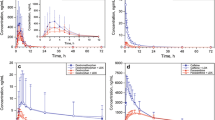Abstract
This case discusses a pharmacokinetic interaction between cimetidine and phenytoin. Phenytoin is a cytochrome P450 2C9 and 2C19 substrate and cimetidine is a cytochrome P450 2C9 and 2C19 inhibitor. Coadministration results in phenytoin toxicity.
Access provided by Autonomous University of Puebla. Download chapter PDF
Similar content being viewed by others
Keywords
- Pharmacokinetic
- Inhibitor
- Inhibition
- Cimetidine
- Phenytoin
- Cimetidine
- CYP2C9
- CYP
- Cytochrome
- P450
- CYP
- 2C9. 2C19
- CYP2C19
- Therapeutic window
- Zero-order kinetics
- Megaloblastic anemia
- Hirsutism
- Gingival hyperplasia
- Agranulocytosis
- Leukopenia
- Toxic epidermal necrolysis
- Nystagmus
- Voltage-gated sodium channels
- Histamine receptor subtype 2 antagonist
- CYP2D6
- CYP3A4
Case
A 56-year-old, 65 kg man presented to the preoperative clinic for evaluation prior to elective hernia repair. He was unsteady on his feet but made it to the examination room where he was dizzy and vomited when attempting to get on the examination table. He reported that he had a history of epilepsy treated with extended-release oral phenytoin (300 mg daily) and gastroesophageal reflux disease (GERD) which had been treated with extended-release pantoprazole (40 mg daily) until 2 weeks prior. The patient had run out of his pantoprazole 2 weeks prior and had not gotten the prescription refilled. Instead, he had purchased an over-the-counter medication for heartburn and had been taking it in the morning and at night. He complained that instead of decreasing his bothersome GERD, he had lately been experiencing worse symptoms.
The patient was noted to be tachycardic and somewhat hypotensive. When the knowledgeable nurse practitioner also ascertained that had nystagmus, tremor, and hyperreflexia, the patient and his spouse were sent to the Emergency Department. A call was placed to the patient’s daughter at home to check on the “heartburn medicine,” which proved to be cimetidine. Routine laboratory values were within reference ranges, but his phenytoin level was elevated at 35 mcg/mL (reference therapeutic range, 10-20 mcg/mL) and a diagnosis of phenytoin toxicity was made. The cimetidine was immediately stopped, and the phenytoin dose was decreased temporarily. The patient’s plasma phenytoin levels decreased to the therapeutic range and his symptoms resolved during the next few days. He underwent an uneventful anesthetic and surgery 2 weeks later.
Discussion
This is an example of an inhibitor added to a substrate.
Phenytoin is an anticonvulsant agent that inhibits the spread of cortical seizure activity. It acts by binding to neuronal sodium ion channels in a frequency-dependent manner, decreasing transmembrane sodium ion flux and thus stabilizing neuronal cell membranes. Phenytoin has a narrow therapeutic index (total phenytoin plasma concentration range, 10-20 mcg/mL). It is extensively metabolized in the liver through the cytochrome P450 (CYP) system, with approximately 80% metabolized by CYP2C9 and 20% by CYP2C19.1 Phenytoin metabolism also displays saturable kinetics.1 When the CYP system is not saturated, the metabolism of phenytoin displays first-order kinetics. When the CYP system is saturated, its metabolism kinetics displays zero-order kinetics, thus appreciably increasing its plasma concentration half-life.
Phenytoin toxicity can manifest in a number of different ways. Acute toxicity results in cerebellar and vestibular symptoms and cardiac dysrhythmias, and chronic toxicity can lead to a paradoxical increase in seizures, megaloblastic anemia, hirsutism, gingival hyperplasia, gastrointestinal symptoms, and lymphoid hyperplasia. Occasionally, such serious adverse effects as agranulocytosis, leukopenia, pancytopenia, thrombocytopenia, and toxic epidermal necrolysis can occur.2
Cimetidine is a histamine receptor subtype 2 (H2) antagonist. It decreases gastric secretions and increases gastric pH by inhibiting the effects of histamine in gastric parietal cells. Also, it is an inhibitor of the CYP enzymes 2C9, 2C19, 2D6, and 3A4.1 Inhibition of these CYP isozymes by cimetidine is known to inhibit the half-life of numerous drugs, including the half-life of phenytoin through inhibition of 2C9 and 2C19. Administration of cimetidine has been shown to decrease the plasma clearance of phenytoin by 16% to 59%.3 , 4 The increase in plasma concentration of phenytoin after treatment with cimetidine normalizes after cimetidine use is discontinued.4
In the present patient, cimetidine use resulted in inhibition of CYP2C9 and CYP2C19 and, subsequently, an increase of phenytoin plasma levels, leading to signs of phenytoin toxicity.
Take-Home Points
-
Phenytoin works by blocking voltage-gated sodium channels in a frequency-dependent manner.
-
Its elimination displays nonlinear kinetics, being first-order at low plasma concentrations and zero-order at greater concentrations.
-
The common adverse effects of phenytoin toxicity are nystagmus, dysarthria, ataxia, and confusion.
-
Medications that inhibit the CYP system, such as cimetidine, can increase the plasma concentration of phenytoin, sometimes to toxic levels.
Summary
-
Interaction: pharmacokinetic (metabolism)
-
Substrate: phenytoin
-
Enzymes: CYP2C9 and CYP2C19
-
Inhibitor: cimetidine
-
Clinical effect: phenytoin toxicity
References
Patsalos PN, Froscher W, Pisani F, et al. The importance of drug interactions in epilepsy therapy. Epilepsia. 2002;43:365–85.
Porter RJ, Meldrum BS. Antiseizure drugs. In: Katzung BG, Masters SB, Trevor AJ, editors. Basic & clinical pharmacology. 11th ed. New York: McGraw-Hill Medical; 2009. p. 399–422.
Sambol NC, Upton RA, Chremos AN, et al. A comparison of the influence of famotidine and cimetidine on phenytoin elimination and hepatic blood flow. Br J Clin Pharmacol. 1989;27:83–7.
Neuvonen PJ, Tokola RA, Kaste M. Cimetidine-phenytoin interaction: effect on serum phenytoin concentration and antipyrine test. Eur J Clin Pharmacol. 1981;21:215–20.
Author information
Authors and Affiliations
Corresponding author
Editor information
Editors and Affiliations
Rights and permissions
Copyright information
© 2015 Springer Science+Business Media New York
About this chapter
Cite this chapter
Subramanian, A., Weingarten, T.N., Sprung, J. (2015). This Antacid Is Making Me Sick!. In: Marcucci, C., et al. A Case Approach to Perioperative Drug-Drug Interactions. Springer, New York, NY. https://doi.org/10.1007/978-1-4614-7495-1_171
Download citation
DOI: https://doi.org/10.1007/978-1-4614-7495-1_171
Publisher Name: Springer, New York, NY
Print ISBN: 978-1-4614-7494-4
Online ISBN: 978-1-4614-7495-1
eBook Packages: MedicineMedicine (R0)



